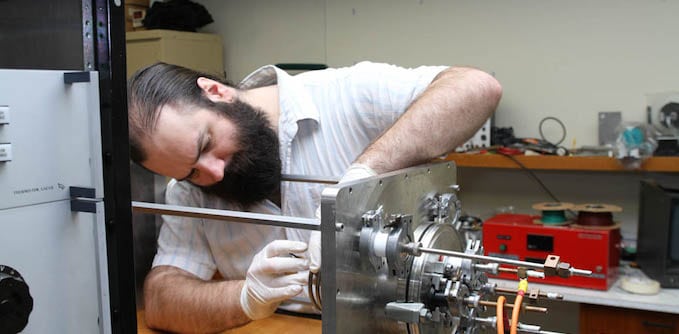Latest News

Patrick “Paddy” Neumann works on the Neumann Drive. Photo: Neumann Space.
An Australian startup is developing a new ion engine that could potentially recycle space junk into fuel to provide thrust for satellites on orbit. According to Neumann Space Founder and Chief Scientist Patrick “Paddy” Neumann, the company’s technology will offer a new level of fuel efficiency while also providing an incentive to clean up space debris.
The Neumann Drive, which is currently at TRL 4 according to NASA’s Technology Readiness Level scale, is a wire-triggered pulsed cathodic arc system. In other words, it functions much like an arc welder, using electricity to heat the fuel material on the tip of a metal cathode. Once ionized, the material is funneled out into space, producing thrust for the asset.
According to Neumann, current flight-rated electric propulsion systems such as Hall effect thrusters use xenon as their propellant. A gas at room temperature and pressure, xenon must be held under high pressure to increase the amount carried in the tank volume, he said. Conversely, because the Neumann Drive uses solid conductive propellants, the system doesn’t require a tank to hold the fuel materials — “nor do we need pumps, pipes, regulators or other pieces of support hardware,” he added.
Neumann Space designed the system to use materials such as aluminum, titanium and magnesium for fuel, “thus creating a motive for cleaning up near-Earth space,” Neumann said. Recycling aluminum is a particularly useful capability, as approximately 7,000 tons of space junk sitting above Geostationary Earth Orbit (GEO) is made of aluminum and could potentially be turned into fuel rods for this technology.
However, Neumann highlighted magnesium and molybdenum as the most promising propellants. “We like magnesium for its very high specific impulse (approximately 10,000s), and molybdenum for its combination of good specific impulse (approximately 5,000s) [and] better thrust-to-power ratio,” he said. Specific impulse is akin to fuel efficiency per pound of material, or “miles per gallon for rockets,” as Neumann phrased it.
Molybdenum is also about 10.3 times as dense as water, he added, making it ideal for volume or power constrained missions.
The higher efficiency of the Neumann Drive relative to current thrusters could potentially enable missions that “would otherwise be uneconomical, such as satellite servicing, space tugs and asteroid mining,” Neumann said. The company has also been able to produce thrust at higher specific impulse than any flight-rated system, which means the drive could send vehicles to more distant destinations while also delivering bigger payloads.
Like Fleet CEO Flavia Tata Nardini, Neumann is an advocate for an Australian national space body. He noted that because Australia is not known for producing space hardware, investors there are not fully cognizant of the risks and opportunities in the sector, which meant it was difficult to secure initial funding for the venture.
“While Australia has the Space Policy Unit and Space Coordination Committee at the federal level, neither of these organizations function as a single point of contact for international organizations looking to partner with Australian entities on space activities, nor do they have the authority to initiate Australian space activities. Personally, I would love for Australia to have a single governing body for space activities — possessing ministerial access and independence — and look forward to the day when we have such,” he said.
Neumann Space is currently finalizing development of its technology before launching the thruster up to the International Space Station (ISS) in February 2019, where it will conduct on-orbit testing atop an Airbus Defense and Space module. The team expects to bring the product to market between 2020 and 2022, initially offering propulsion for small satellites in the 100- to 250-kg range. “Larger vehicles would be to operate multiple arrays in parallel,” he added. “We also believe that we would be able to miniaturize the system so that it would fit into the volume format of a single CubeSat unit, thus providing propulsion for 3U CubeSats and similar.”
Neuman sees this technology as a general boon for the industry, as it could enable more space activities at lower engineering and financial costs. “We hope that pulsed arc thrusters become more common in future, not only for selfish reasons involving the financial success of our company, but also for what it would mean for broader human activities in space,” he said.
Get the latest Via Satellite news!
Subscribe Now